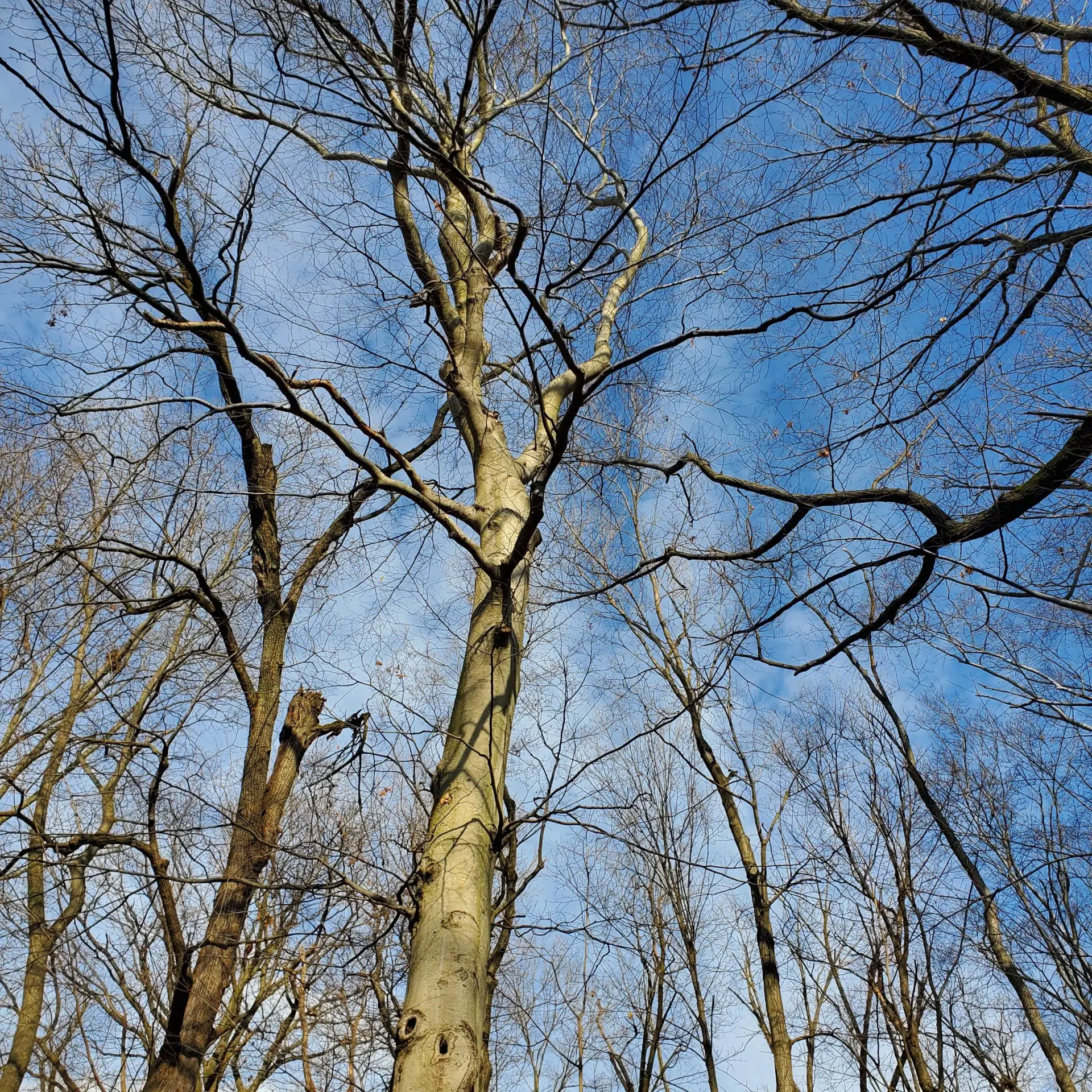Trees
American Beech
Fagus grandifolia

American beech (Fagus grandifolia) is a tree native to eastern North American. It is the only beech (genus Fagus) native to North America.
Native range
The geographic range of American beech extends to Nova Scotia, southern Quebec and Ontario in the north; to Wisconsin, Missouri, and eastern Texas in the west, and reaches northern Florida in the south. Higher than average summer temperatures are unfavorable for beech growth and may place a limit on its southern and western range.
Beech habitat
Compared to other trees within its range, American beech uses twice as much water for transpiration and annual growth, making moderate to poorly drained soils, coniferous forests, stream banks, and moderately shaded areas good habitat for beech. However, while having a high need for water they are not tolerant of flooding.
Specs & lifecycle
The average mature height of American beech is 60-80 feet tall. They can be slow growing and even small diameter beech can be very old; 5.5-inch diameter beech trunks were found to be on average about 80 years old. American beech can live up to 250 years while only reaching a trunk diameter of 20-inches. Some of the oldest beeches recorded have been found in Pennsylvania and were estimated to be at least 366 years old. One of the largest beeches ever recorded was found in Michigan, with a 53-inch diameter trunk and stood 160 ft. tall.
Mature beech trees are usually 40 years old when they start to have their first nut (seed) production. Flowers are vulnerable to spring frost, which can reduce nut production. Usually there are two nuts per beech bur (seed pod), and heavy frosts cause burs to open in the fall so nuts can reach the ground. Mature beech trees experience high nut production in 2- to 8-year intervals. Although beech nuts drop close to the tree, like other heavy nuts they are dispersed with help from birds like blue jays as well as small mammals. Beech can develop many root sprouts or suckers along its surface roots, resulting in the formation of thick stands of individual clones near mature trees. While deer may partake in eating beech nuts, they do not prefer the leaves or bark for browsing.
Threats to American beech
With its characteristic thin and smooth grey bark, beech is susceptible to damage from parasitic fungi, plant-sucking insects, forest fires and spring frosts. The insect Cryptococcus fagisuga is a plant sucking, scale-like insect that can pierce the bark of American beech for feeding. The damage caused to the bark by C. fagisuga feeding can allow the bark to be invaded by a canker fungus, Neonectria spp., and these fungi can eventually girdle a tree and lead to its death. This combination of the scale insect and canker fungi creates an insect-fungus interaction known as beech bark disease (BBD). Beech bark disease was introduced from Europe into North America around 1890 but became highly noticeable in woodlands after 1980.
BBD has resulted in the loss of many mature beech from the northeastern United States, with impacts on forest ecology, especially since affected stands may have reduced nut production. Areas of mature beech can turn into beech sapling thickets which are root sprouts that grow in response to mature beech stress. These smaller beeches compete for resources with yellow birch, eastern hemlock and maple tree regeneration. Turnover of forest tree composition like this impact’s multiple ecological aspects, including soil chemistry, invasive plant communities and the local water cycle.
American beech is also impacted by beech blight aphid (Grylloprociphilus imbricator), a small insect that sucks out beech sap and has a bright white fuzzy hind-end. Many of them gather in clusters along the twigs and sway back and forth in a type of dancing movement as defense when the twig is disturbed or moved.
More significantly, in 2012 issues with distorted and malformed beech leaves which eventually lead to leaf death were observed in northeast Ohio. This condition called beech leaf disease (BLD) can cause premature leaf-drop and eventual mortality. BLD is also characterized by darkening and thickening of the cells in between the leaf veins, as to create leaves that can look as if they have dark green stripes or, with worse symptoms, become completely dark green and leathery. Research has shown that BLD is associated with a non-native nematode (L. crenatae subsp. mccannii), a very small (about 0.1 mm long) worm-like organism that has been found in beech buds which grow into leaves. Some research also suggests that bacterial communities may be different between leaves symptomatic and leaves asymptomatic for beech leaf disease, suggesting that some bacteria could contribute to BLD in some fashion; for example, as an opportunistic pathogen that takes advance of the damage created by nematode feeding behavior. But this possibility is still uncertain and requires additional study.
Silviculture research has shown that heavy or clear-cutting beech forests results in fewer beech repopulating the new stand when compared to old untouched stands; likely due to greater sunlight in clear-cut areas which can result in drier conditions or greater growth by sun tolerant tree species which can outcompete beech. Canopy thinning for landscape specimens of American beech may increase air circulation and help control spread and incidence of beech leaf disease. The U.S. Forest Service has found beech resistant to beech bark disease and used these individuals to create small resistant populations of beech. Current work is underway to assess whether some beech individuals may also be resistant to beech leaf disease.




